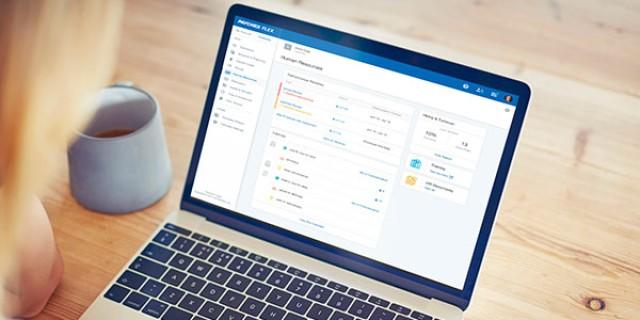- Retirement
- Article
- 6 min. Read
- Last Updated: 02/04/2025
What Is a 401(k) Plan and How Does It Work?

Table of Contents
A 401(k) plan is among the most popular employee benefits, appealing to both job candidates and employees. But what is a 401(k)? It's a retirement savings plan that allows participants to contribute a portion of their wages on a pre-tax or Roth (after-tax) basis.
Here's what makes 401(k) plans valuable for your organization:
- Win the talent war: Match your employees' contributions and watch your recruiting get easier — money talks when candidates compare offers.
- Provide tax advantages that matter: Help your team build wealth through tax-deferred or tax-free investment growth, demonstrating your commitment to their long-term financial security.
- Keep it simple but effective: A straightforward mix of mutual funds, stocks, and bonds lets your employees save for retirement without overwhelming them with choices.
Bottom line: A solid 401(k) plan helps you compete for talent.
What Is a 401(k) Plan?
A 401(k) plan is a retirement savings plan established by employers that allows employees to contribute a portion of their wages, either pre-tax or Roth (after-tax), to save for retirement.
Regulated by the Internal Revenue Service (IRS), these plans provide significant tax advantages, including tax-deferred growth for traditional accounts or tax-free growth for Roth accounts. Employees can contribute up to an annual limit set by the IRS, with many plans offering additional employer-matching contributions to encourage saving.
Since employee contributions to 401(k) plans are typically deducted directly from paychecks, these plans make it easy and convenient for employees to build their retirement savings.
What Are the Different Types of 401(k)s?
A 401(k) gets its name from the IRS tax code section that governs it. While all 401(k)s must follow certain rules, companies have room to customize their plans to fit their needs. Here are some examples:
- Traditional 401(k): The traditional version of a 401(k) plan can be offered by employers of all sizes and has some flexibility in how much employees and employers contribute to the plan, up to the limitations set by the IRS Code.
- Pooled Employer 401(k) Plan: The Pooled Employer Plan (PEP) allows employers of any size to pool assets into a 401(k) plan administered by a professional Pooled Plan Provider. It's ideal for businesses who want an easy-to-manage, turnkey 401(k) plan with simplified administration and reduced fiduciary risk.
- Roth 401(k): This plan combines the features of a Roth IRA and traditional 401(k), allowing employees to contribute after-tax dollars to the plan, thus avoiding later taxation.
- Solo 401(k): Often referred to as a "self-employed 401(k)," this plan is specifically designed for employers who have no full-time employees other than the business owner and spouse.
- Safe Harbor 401(k): The safe harbor 401(k) plan stipulates that employer contributions are fully vested immediately upon contribution, avoiding many of the annual compliance tests required by other 401(k) plans.
- Simple 401(k): To qualify for this plan, the sponsoring employer must have 100 or fewer employees and not offer any other retirement plans. Simple 401(k)s restrict employers to certain contribution and filing requirements.
- Profit-sharing: This unique plan allows employers to contribute on behalf of the employee based on the company's profits; only the employer can contribute to this plan. Employee elective contributions are not allowed.
- 403(b): These plans are similar to 401(k) plans but can only be offered to employees of nonprofit organizations or certain government employers.
How Does a 401(k) Work?
Traditionally, 401(k) plans are established through an employer in association with other benefit options. When employees become benefits-eligible, some plans use an auto-enrollment feature. Alternatively, employees may be able to sign up for the plan and set up their retirement account for designated 401(k) contributions as part of the benefits enrollment process. Self-employed individuals can also enroll in a solo 401(k) through a qualified provider.
Once the plan is initiated, the employee's designated contribution amounts are processed through payroll deduction on a pre-tax (or post-tax for a Roth 401(k)) basis. The employer then deposits the payroll deduction amount and any 401(k) match contributions into the employee's designated account.
After the contributions are made, employees typically have access to an online portal to track the account value and performance over time, choose designated investment percentages, or borrow money against the value in the account.
Rules of a 401(k): Withdrawals and Transfers
Since 401(k)s are designed as a long-term savings vehicle for retirement, withdrawing or transferring money in and out of the account aren't simple processes.
Taking money out before age 59½ usually comes with a hefty price tag, making understanding when and how to withdraw from a 401(k) plan essential. Traditional 401(k) withdrawals not only count as taxable income but also trigger an IRS penalty. Even Roth withdrawals — which are normally tax-free — face IRS penalties if taken too early. This hits your pocket twice: once with taxes and again with the 401(k) early withdrawal penalty itself.
Fortunately, employees can make a penalty-free 401(k) withdrawal if:
- Employees are taking a qualified disaster distribution of less than $100,000 due to certain FEMA-declared disasters;
- Employees are withdrawing from a tax-deferred account and are a named beneficiary, a qualified reservist, permanently disabled, or have reached age 59 ½; or
- Employees are withdrawing from a Roth account that has been open for at least 5 tax years and are a named beneficiary, a qualified reservist, permanently disabled, or have reached age 59 ½.
Sometimes, employees may want to transfer money from an existing 401(k), such as when changing jobs to a new employer. A cash-out of the account will typically result in penalties and taxes, but rolling the money over to another 401(k) plan or individual retirement arrangement can help employees avoid those deductions.
While employees can't transfer funds from a 401(k) account to their personal savings account penalty-free, they can avoid most penalties by transferring them to another qualified retirement account, such as an IRA, another 401(k) plan, or even a 403(b) plan.
Rules of a 401(k): Contributions and Limits
The IRS regulations governing 401(k) plans also specify an individual's max 401(k) contribution limit. These restrictions are designed to prevent the abuse of these plans by highly compensated employees and encourage early retirement planning. The contribution limits are adjusted periodically for inflation, and updated limits are published on the IRS website.
2025 401(k) Contribution Limits
The IRS has set the following 401(k) contribution limits for 2025:
Elective Deferrals
- SIMPLE 401(k): $16,500 per year in elective deferrals
- Traditional 401(k) and Safe Harbor Plans: $23,500 per year in elective deferrals
Catch-Up Contributions
- SIMPLE 401(k) (Age 50 and Older): $3,500 per year in catch-up contributions
- Traditional 401(k) and Safe Harbor Plans (Age 50+): $7,500 per year in catch-up contributions
- Traditional 401(k) and Safe Harbor Plans (Age 60–63): $11,250 in catch-up contributions
Total Contributions (Employee + Employer):
- All Employees: $70,000 per year in total contributions (employee elective deferrals and employer contributions combined)
- Employees Aged 50 and Older: $77,500 per year in total contributions (employee elective deferrals plus catch-up contributions and employer contributions)
- Employees Aged 60 to 63: $81,250 per year in total contributions (employee elective deferrals plus catch-up contributions and employer contributions)
Employers can elect to match employee contributions as an additional benefit, but this is not required. Any employer match or other contribution is subject to the total contribution limits listed above.
401(k) Nondiscrimination Requirements
When employers offer 401(k) plans to employees, those plans are subject to obligations and tests from the IRS to ensure the plan complies with the tax code. These obligations and tests are designed to ensure that owners and partial owners — often referred to as "highly compensated employees" — cannot use 401(k) plans to shelter company profits or otherwise unfairly benefit compared to non-key employees.
A traditional plan must comply with:
- Average Deferral Percentage ("ADP") test compares the deferrals of highly compensated versus non-highly compensated employees.
- Average Contribution Percentage ("ACP") test compares employer matching contributions and employee after-tax contributions for highly compensated versus non-highly compensated employees.
- Top-Heavy Test evaluates the overall benefits in the plan for key employees, such as owners and officers, compared to benefits received by non-key employees.
<p></p>
Pros and Cons of a 401(k) Plan
Creating a savings plan is an important part of preparing for retirement. Like any savings tool, a 401(k) has pros and cons. For many employees, 401(k)s are one of the best retirement planning vehicles for maximizing savings, but investing generally involves some risk.
Your employees should be aware of the most common pros and cons of a 401(k) retirement savings plan before investing in one.
Pros
- Employers can match contributions (although not required), essentially giving employees free money
- Employers also can make a profit-sharing contribution and other employer contributions (although not required) that are not tied to employee deferrals
- All plans must meet strict legal standards to protect employees' money and interests
- In a financial emergency, employees may be eligible to borrow against funds in their vested account instead of paying interest to a bank or other financial institution through a traditional loan
- Most plans allow employees to defer income taxes until the funds are withdrawn
Cons
- Employees may have limited investment options
- Employees will typically be charged additional penalties to access their money before age 59 ½
- For non-Roth deferrals, employees must pay taxes even once they reach retirement age, which could be when you need your money the most
What You Might Not Know: Common 401(k) Misconceptions
Many people have misconceptions about how 401(k) plans work, leading to confusion about their benefits and limitations. Here are a few common misunderstandings clarified:
- Funds are inaccessible before retirement: While 401(k) accounts are designed for long-term savings, participants may access their funds under specific circumstances, such as financial hardship, taking out a loan (if available), or initiating a 401(k) rollover into a new retirement account (if eligible). However, most early withdrawals incur penalties and taxes.
- Employer contributions are automatic: While many employers require employees to contribute to receive matching funds, some plans provide employer contributions regardless of employee participation. Additionally, certain employers offer discretionary profit-sharing contributions that can significantly boost retirement savings. Understanding the terms of the workplace retirement plan is key to maximizing these benefits for both employees and employers.
- The employer handles investment management entirely: While employers provide a curated list of the plan’s investment options, employees are empowered to choose from this list, allowing them to tailor their investment strategy to their personal goals and risk preferences. This control gives employees an active role in managing their 401(k) and planning for their future.
Clearing up these misconceptions allows employers to better educate their teams about the value of 401(k) plans. This empowers employees to make informed decisions and take full advantage of the benefits provided by their organization.
Getting Started With a 401(k)
Choosing the right retirement plan—whether it's a Simple IRA or a 401(k)—can be challenging. The next piece is enrollment: each company handles this differently, and many have waiting periods before new employees can join.
Eligible employees must receive a summary plan document that provides information about their plan and its available options. If they're unsure how much to save each paycheck, offer them resources such as Paychex's 401(k) calculator to help them estimate expected contributions and account earnings over time.
Start Building a Stronger Workforce With Your 401(k) Plan
A 401(k) plan strengthens your compensation package and gives you an edge in recruiting. The tax advantages and investment options help your employees grow their retirement savings faster.
Better yet, employees who value their 401(k) benefits tend to stick around — that's good for your bottom line.
Tags







